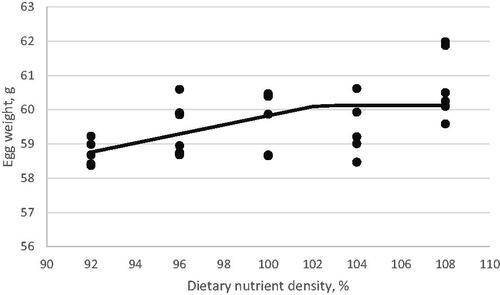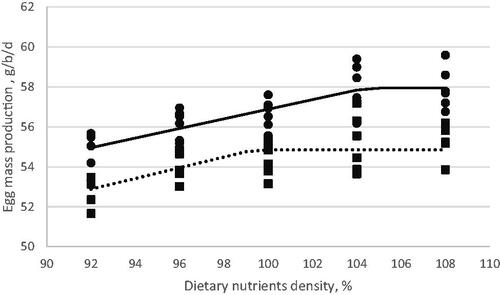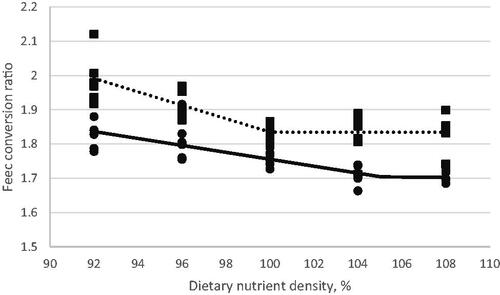Figures & data
Table 1. Ingredients and nutrients composition of experimental diets.
Table 2. Calculated daily absolute intakes of energy and selected nutrients in the laying hens during the peak production phase of the first laying cyclea.
Table 3. Effect of dietary energy and nutrients density on egg production performance of laying hens during the peak production phase of the first laying cyclea.
Table 4. Effect of dietary energy and nutrients density on live body weight of laying hens during the peak production phase of the first laying cyclea.
Table 5. Effect of dietary energy and nutrients density on egg quality of laying hens during the peak production phase of the first laying cyclea.
Table 6. Effect of dietary energy and nutrients density on egg composition of laying hens during the peak production phase of the first laying cycle determined at the end of the experimenta.
Table 7. Effect of dietary energy and nutrients density on blood metabolites of laying hens during the peak production phase of the first laying cycle determined at the end of the experimenta.
Figure 1. Fitted broken-line plot of hen-day egg production of Hy-line-W36 laying hens during the peak production phase of the first laying cycle as a function of diet nutrients density (% of strain recommendation). (—●) Liner broken-line fitted model for 26–29 weeks of age period, Y = 95.46–0.167(104-X) × I, I = 1 (if X < 104) or I = 0 (if X > 104), p < .015, R2 = 0.26, the break point occurred at 104 ± 4.63. (…■) Liner broken-line fitted plot for 30–33 weeks of age period; Y = 90.13–0.2 (98.5-X) × I, I = 1 (if X < 98.5) or I = 0 (if X > 98.5), p < .034, R2 = 0.22, the break point occurred at 98.5 ± 3.81.

Figure 2. Fitted broken-line plot of average egg weight of Hy-line-W36 laying hens during the peak production phase of the first laying cycle as a function of diet nutrients density (% of strain recommendation). Liner broken-line fitted model for 26–29 weeks of age period; Y = 60.12–0.13 (102-X) × I, I = 1 (if X < 102) or I = 0 (if X > 102), p < .008, R2 = 0.30, the break point occurred at 102 ± 3.75.

Figure 3. Fitted broken-line plot of egg mass of Hy-line-W36 laying hens during the peak production phase of the first laying cycle as a function of diet nutrients density (% of strain recommendation). (—●) Liner broken-line fitted plot for 26–29 weeks of age period; Y = 57.93–0.24 (104.4-X) × I, I = 1 (if X < 104.4) or I = 0 (if X > 104.4), p < .015, R2 = 0.62, the break point occurred at 104.4 ± 4.63. (…■) Liner broken-line fitted plot for 30–33 weeks of age period; Y = 54.85–0.27 (99.4-X) × I, I = 1 (if X < 99.4) or I = 0 (if X > 99.4), p < .001, R2 = 0.42, the break point occurred at 99.4 ± 3.81.

Figure 4. Fitted broken-line plot of feed conversion ratio of Hy-line-W36 laying hens during the peak production phase of the first laying cycle as a function of diet nutrients density (% of strain recommendation). (—●) Liner broken-line fitted plot for 26–29 weeks of age period; Y = 1.703 + 0.01 (105-X) × I, I = 1 (if X < 105) or I = 0 (if X > 105), p < .001, R2 = 0.73, the break point occurred at 105.2 ± 1.87. (…■) Liner broken-line fitted plot for 30–33 weeks of age period; Y = 1.8345–0.0196 (100-X) × I, I = 1 (if X < 100) or I = 0 (if X > 100), p < .001, R2 = 0.60, the break point occurred at 100 ± 1.3.

Table 8. Estimated metabolisable energy and nutrients requirements of laying hens during the peak production phase of the first laying cycle by the linear broken-line fit model.
